PepsiCo: Operations, Leadership, and Business Environment Analysis
VerifiedAdded on 2021/10/11
|6
|2206
|261
Report
AI Summary
This report provides a comprehensive analysis of PepsiCo's operations management, leadership roles, and the impact of external business environment factors. It delves into the key functions of operations management, including product development, quality management, process and capacity design, location strategy, and supply chain management. The report explores the roles of managers and leaders in achieving business objectives, such as survival, sales growth, profit maximization, customer satisfaction, and expansion. It also examines the influence of socio-cultural, technological, economic, political, and environmental factors on PepsiCo's operations and strategies. Furthermore, the report highlights the application of operational approaches like Total Quality Management, Just-In-Time, and Six Sigma. The conclusion emphasizes the importance of effective operations management and leadership in driving organizational success and achieving sustainable business outcomes. The report also touches on PepsiCo's commitment to sustainability and social responsibility, showcasing their efforts in environmental conservation and community support.
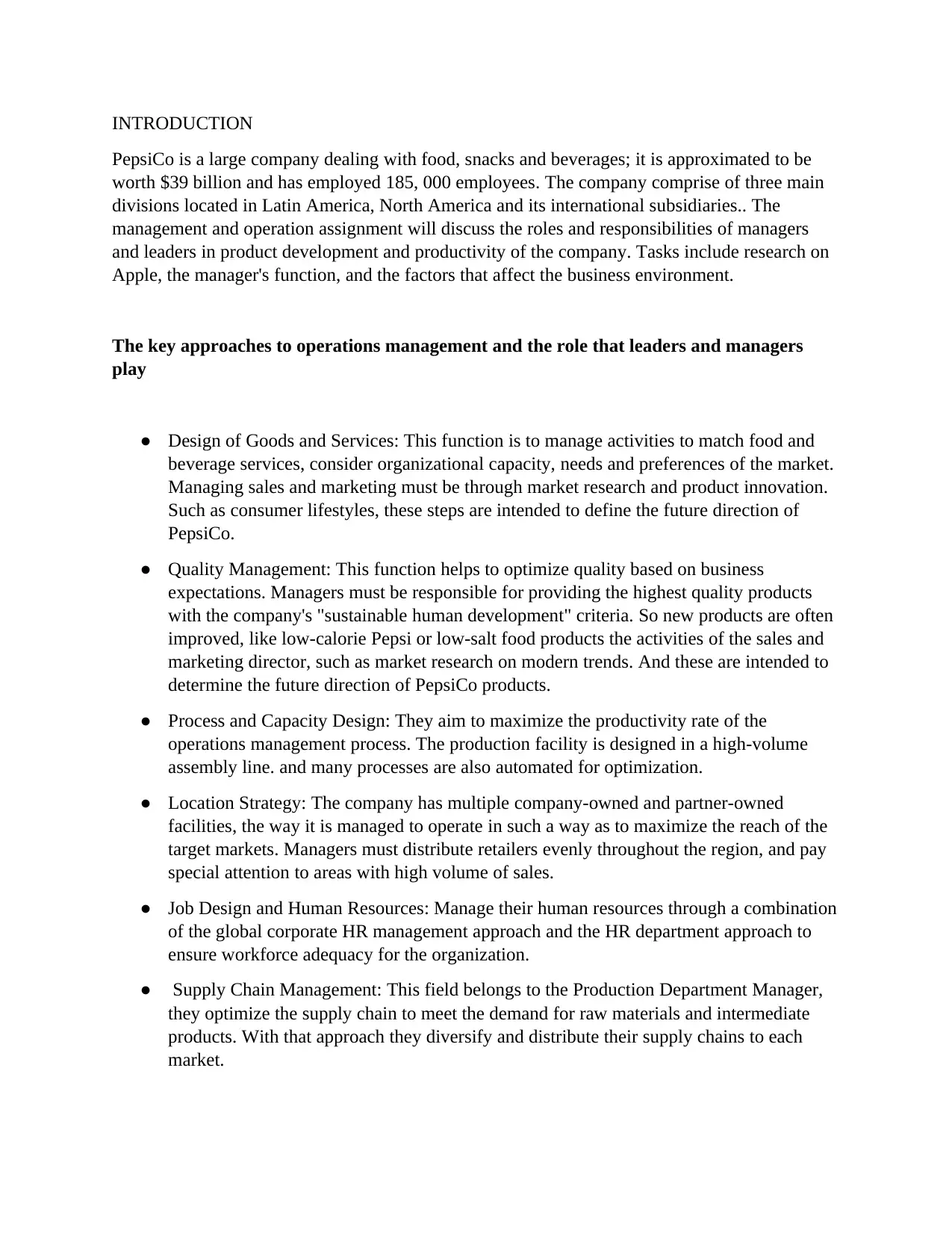
INTRODUCTION
PepsiCo is a large company dealing with food, snacks and beverages; it is approximated to be
worth $39 billion and has employed 185, 000 employees. The company comprise of three main
divisions located in Latin America, North America and its international subsidiaries.. The
management and operation assignment will discuss the roles and responsibilities of managers
and leaders in product development and productivity of the company. Tasks include research on
Apple, the manager's function, and the factors that affect the business environment.
The key approaches to operations management and the role that leaders and managers
play
● Design of Goods and Services: This function is to manage activities to match food and
beverage services, consider organizational capacity, needs and preferences of the market.
Managing sales and marketing must be through market research and product innovation.
Such as consumer lifestyles, these steps are intended to define the future direction of
PepsiCo.
● Quality Management: This function helps to optimize quality based on business
expectations. Managers must be responsible for providing the highest quality products
with the company's "sustainable human development" criteria. So new products are often
improved, like low-calorie Pepsi or low-salt food products the activities of the sales and
marketing director, such as market research on modern trends. And these are intended to
determine the future direction of PepsiCo products.
● Process and Capacity Design: They aim to maximize the productivity rate of the
operations management process. The production facility is designed in a high-volume
assembly line. and many processes are also automated for optimization.
● Location Strategy: The company has multiple company-owned and partner-owned
facilities, the way it is managed to operate in such a way as to maximize the reach of the
target markets. Managers must distribute retailers evenly throughout the region, and pay
special attention to areas with high volume of sales.
● Job Design and Human Resources: Manage their human resources through a combination
of the global corporate HR management approach and the HR department approach to
ensure workforce adequacy for the organization.
● Supply Chain Management: This field belongs to the Production Department Manager,
they optimize the supply chain to meet the demand for raw materials and intermediate
products. With that approach they diversify and distribute their supply chains to each
market.
PepsiCo is a large company dealing with food, snacks and beverages; it is approximated to be
worth $39 billion and has employed 185, 000 employees. The company comprise of three main
divisions located in Latin America, North America and its international subsidiaries.. The
management and operation assignment will discuss the roles and responsibilities of managers
and leaders in product development and productivity of the company. Tasks include research on
Apple, the manager's function, and the factors that affect the business environment.
The key approaches to operations management and the role that leaders and managers
play
● Design of Goods and Services: This function is to manage activities to match food and
beverage services, consider organizational capacity, needs and preferences of the market.
Managing sales and marketing must be through market research and product innovation.
Such as consumer lifestyles, these steps are intended to define the future direction of
PepsiCo.
● Quality Management: This function helps to optimize quality based on business
expectations. Managers must be responsible for providing the highest quality products
with the company's "sustainable human development" criteria. So new products are often
improved, like low-calorie Pepsi or low-salt food products the activities of the sales and
marketing director, such as market research on modern trends. And these are intended to
determine the future direction of PepsiCo products.
● Process and Capacity Design: They aim to maximize the productivity rate of the
operations management process. The production facility is designed in a high-volume
assembly line. and many processes are also automated for optimization.
● Location Strategy: The company has multiple company-owned and partner-owned
facilities, the way it is managed to operate in such a way as to maximize the reach of the
target markets. Managers must distribute retailers evenly throughout the region, and pay
special attention to areas with high volume of sales.
● Job Design and Human Resources: Manage their human resources through a combination
of the global corporate HR management approach and the HR department approach to
ensure workforce adequacy for the organization.
● Supply Chain Management: This field belongs to the Production Department Manager,
they optimize the supply chain to meet the demand for raw materials and intermediate
products. With that approach they diversify and distribute their supply chains to each
market.
Paraphrase This Document
Need a fresh take? Get an instant paraphrase of this document with our AI Paraphraser
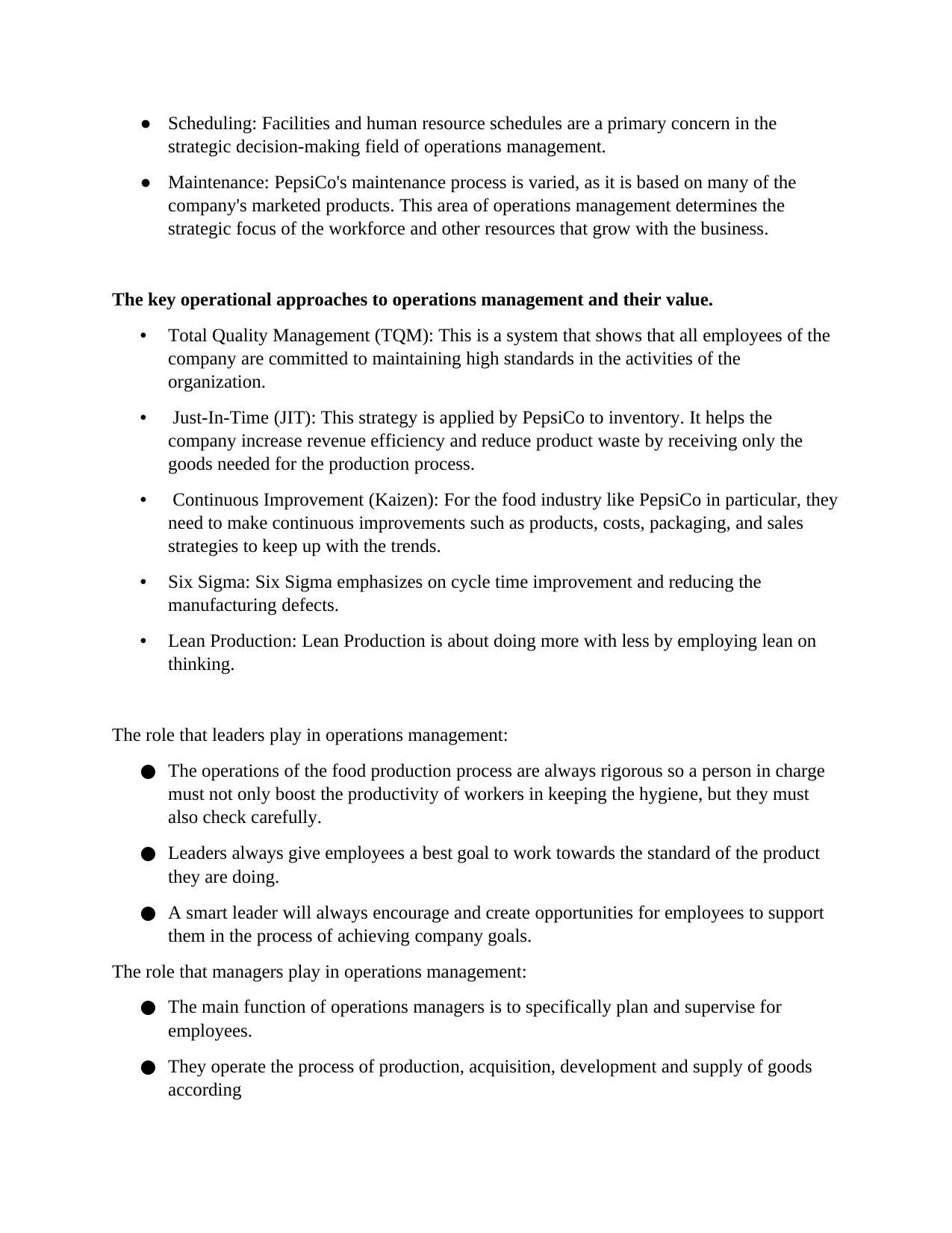
● Scheduling: Facilities and human resource schedules are a primary concern in the
strategic decision-making field of operations management.
● Maintenance: PepsiCo's maintenance process is varied, as it is based on many of the
company's marketed products. This area of operations management determines the
strategic focus of the workforce and other resources that grow with the business.
The key operational approaches to operations management and their value.
• Total Quality Management (TQM): This is a system that shows that all employees of the
company are committed to maintaining high standards in the activities of the
organization.
• Just-In-Time (JIT): This strategy is applied by PepsiCo to inventory. It helps the
company increase revenue efficiency and reduce product waste by receiving only the
goods needed for the production process.
• Continuous Improvement (Kaizen): For the food industry like PepsiCo in particular, they
need to make continuous improvements such as products, costs, packaging, and sales
strategies to keep up with the trends.
• Six Sigma: Six Sigma emphasizes on cycle time improvement and reducing the
manufacturing defects.
• Lean Production: Lean Production is about doing more with less by employing lean on
thinking.
The role that leaders play in operations management:
● The operations of the food production process are always rigorous so a person in charge
must not only boost the productivity of workers in keeping the hygiene, but they must
also check carefully.
● Leaders always give employees a best goal to work towards the standard of the product
they are doing.
● A smart leader will always encourage and create opportunities for employees to support
them in the process of achieving company goals.
The role that managers play in operations management:
● The main function of operations managers is to specifically plan and supervise for
employees.
● They operate the process of production, acquisition, development and supply of goods
according
strategic decision-making field of operations management.
● Maintenance: PepsiCo's maintenance process is varied, as it is based on many of the
company's marketed products. This area of operations management determines the
strategic focus of the workforce and other resources that grow with the business.
The key operational approaches to operations management and their value.
• Total Quality Management (TQM): This is a system that shows that all employees of the
company are committed to maintaining high standards in the activities of the
organization.
• Just-In-Time (JIT): This strategy is applied by PepsiCo to inventory. It helps the
company increase revenue efficiency and reduce product waste by receiving only the
goods needed for the production process.
• Continuous Improvement (Kaizen): For the food industry like PepsiCo in particular, they
need to make continuous improvements such as products, costs, packaging, and sales
strategies to keep up with the trends.
• Six Sigma: Six Sigma emphasizes on cycle time improvement and reducing the
manufacturing defects.
• Lean Production: Lean Production is about doing more with less by employing lean on
thinking.
The role that leaders play in operations management:
● The operations of the food production process are always rigorous so a person in charge
must not only boost the productivity of workers in keeping the hygiene, but they must
also check carefully.
● Leaders always give employees a best goal to work towards the standard of the product
they are doing.
● A smart leader will always encourage and create opportunities for employees to support
them in the process of achieving company goals.
The role that managers play in operations management:
● The main function of operations managers is to specifically plan and supervise for
employees.
● They operate the process of production, acquisition, development and supply of goods
according
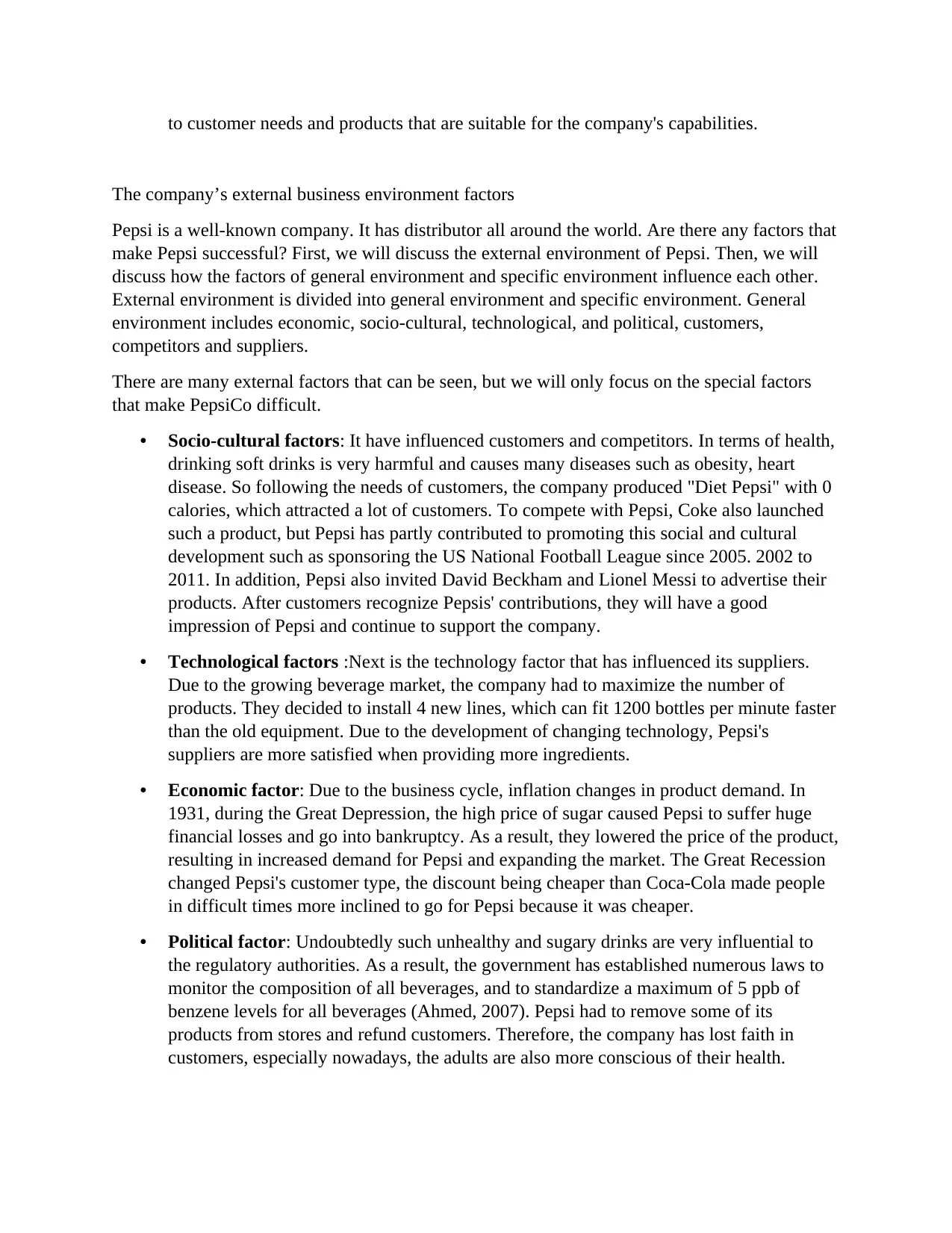
to customer needs and products that are suitable for the company's capabilities.
The company’s external business environment factors
Pepsi is a well-known company. It has distributor all around the world. Are there any factors that
make Pepsi successful? First, we will discuss the external environment of Pepsi. Then, we will
discuss how the factors of general environment and specific environment influence each other.
External environment is divided into general environment and specific environment. General
environment includes economic, socio-cultural, technological, and political, customers,
competitors and suppliers.
There are many external factors that can be seen, but we will only focus on the special factors
that make PepsiCo difficult.
• Socio-cultural factors: It have influenced customers and competitors. In terms of health,
drinking soft drinks is very harmful and causes many diseases such as obesity, heart
disease. So following the needs of customers, the company produced "Diet Pepsi" with 0
calories, which attracted a lot of customers. To compete with Pepsi, Coke also launched
such a product, but Pepsi has partly contributed to promoting this social and cultural
development such as sponsoring the US National Football League since 2005. 2002 to
2011. In addition, Pepsi also invited David Beckham and Lionel Messi to advertise their
products. After customers recognize Pepsis' contributions, they will have a good
impression of Pepsi and continue to support the company.
• Technological factors :Next is the technology factor that has influenced its suppliers.
Due to the growing beverage market, the company had to maximize the number of
products. They decided to install 4 new lines, which can fit 1200 bottles per minute faster
than the old equipment. Due to the development of changing technology, Pepsi's
suppliers are more satisfied when providing more ingredients.
• Economic factor: Due to the business cycle, inflation changes in product demand. In
1931, during the Great Depression, the high price of sugar caused Pepsi to suffer huge
financial losses and go into bankruptcy. As a result, they lowered the price of the product,
resulting in increased demand for Pepsi and expanding the market. The Great Recession
changed Pepsi's customer type, the discount being cheaper than Coca-Cola made people
in difficult times more inclined to go for Pepsi because it was cheaper.
• Political factor: Undoubtedly such unhealthy and sugary drinks are very influential to
the regulatory authorities. As a result, the government has established numerous laws to
monitor the composition of all beverages, and to standardize a maximum of 5 ppb of
benzene levels for all beverages (Ahmed, 2007). Pepsi had to remove some of its
products from stores and refund customers. Therefore, the company has lost faith in
customers, especially nowadays, the adults are also more conscious of their health.
The company’s external business environment factors
Pepsi is a well-known company. It has distributor all around the world. Are there any factors that
make Pepsi successful? First, we will discuss the external environment of Pepsi. Then, we will
discuss how the factors of general environment and specific environment influence each other.
External environment is divided into general environment and specific environment. General
environment includes economic, socio-cultural, technological, and political, customers,
competitors and suppliers.
There are many external factors that can be seen, but we will only focus on the special factors
that make PepsiCo difficult.
• Socio-cultural factors: It have influenced customers and competitors. In terms of health,
drinking soft drinks is very harmful and causes many diseases such as obesity, heart
disease. So following the needs of customers, the company produced "Diet Pepsi" with 0
calories, which attracted a lot of customers. To compete with Pepsi, Coke also launched
such a product, but Pepsi has partly contributed to promoting this social and cultural
development such as sponsoring the US National Football League since 2005. 2002 to
2011. In addition, Pepsi also invited David Beckham and Lionel Messi to advertise their
products. After customers recognize Pepsis' contributions, they will have a good
impression of Pepsi and continue to support the company.
• Technological factors :Next is the technology factor that has influenced its suppliers.
Due to the growing beverage market, the company had to maximize the number of
products. They decided to install 4 new lines, which can fit 1200 bottles per minute faster
than the old equipment. Due to the development of changing technology, Pepsi's
suppliers are more satisfied when providing more ingredients.
• Economic factor: Due to the business cycle, inflation changes in product demand. In
1931, during the Great Depression, the high price of sugar caused Pepsi to suffer huge
financial losses and go into bankruptcy. As a result, they lowered the price of the product,
resulting in increased demand for Pepsi and expanding the market. The Great Recession
changed Pepsi's customer type, the discount being cheaper than Coca-Cola made people
in difficult times more inclined to go for Pepsi because it was cheaper.
• Political factor: Undoubtedly such unhealthy and sugary drinks are very influential to
the regulatory authorities. As a result, the government has established numerous laws to
monitor the composition of all beverages, and to standardize a maximum of 5 ppb of
benzene levels for all beverages (Ahmed, 2007). Pepsi had to remove some of its
products from stores and refund customers. Therefore, the company has lost faith in
customers, especially nowadays, the adults are also more conscious of their health.
⊘ This is a preview!⊘
Do you want full access?
Subscribe today to unlock all pages.

Trusted by 1+ million students worldwide
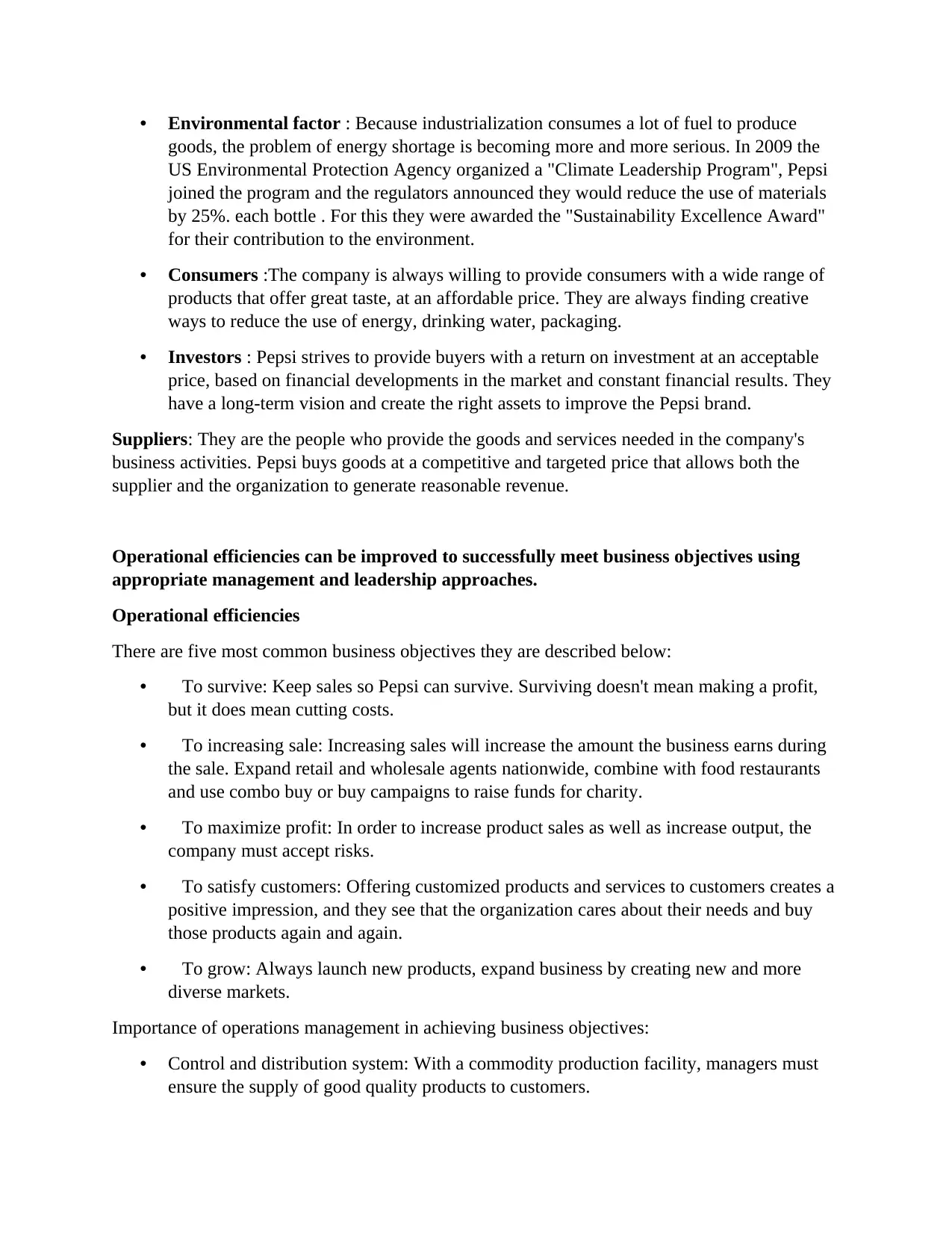
• Environmental factor : Because industrialization consumes a lot of fuel to produce
goods, the problem of energy shortage is becoming more and more serious. In 2009 the
US Environmental Protection Agency organized a "Climate Leadership Program", Pepsi
joined the program and the regulators announced they would reduce the use of materials
by 25%. each bottle . For this they were awarded the "Sustainability Excellence Award"
for their contribution to the environment.
• Consumers :The company is always willing to provide consumers with a wide range of
products that offer great taste, at an affordable price. They are always finding creative
ways to reduce the use of energy, drinking water, packaging.
• Investors : Pepsi strives to provide buyers with a return on investment at an acceptable
price, based on financial developments in the market and constant financial results. They
have a long-term vision and create the right assets to improve the Pepsi brand.
Suppliers: They are the people who provide the goods and services needed in the company's
business activities. Pepsi buys goods at a competitive and targeted price that allows both the
supplier and the organization to generate reasonable revenue.
Operational efficiencies can be improved to successfully meet business objectives using
appropriate management and leadership approaches.
Operational efficiencies
There are five most common business objectives they are described below:
• To survive: Keep sales so Pepsi can survive. Surviving doesn't mean making a profit,
but it does mean cutting costs.
• To increasing sale: Increasing sales will increase the amount the business earns during
the sale. Expand retail and wholesale agents nationwide, combine with food restaurants
and use combo buy or buy campaigns to raise funds for charity.
• To maximize profit: In order to increase product sales as well as increase output, the
company must accept risks.
• To satisfy customers: Offering customized products and services to customers creates a
positive impression, and they see that the organization cares about their needs and buy
those products again and again.
• To grow: Always launch new products, expand business by creating new and more
diverse markets.
Importance of operations management in achieving business objectives:
• Control and distribution system: With a commodity production facility, managers must
ensure the supply of good quality products to customers.
goods, the problem of energy shortage is becoming more and more serious. In 2009 the
US Environmental Protection Agency organized a "Climate Leadership Program", Pepsi
joined the program and the regulators announced they would reduce the use of materials
by 25%. each bottle . For this they were awarded the "Sustainability Excellence Award"
for their contribution to the environment.
• Consumers :The company is always willing to provide consumers with a wide range of
products that offer great taste, at an affordable price. They are always finding creative
ways to reduce the use of energy, drinking water, packaging.
• Investors : Pepsi strives to provide buyers with a return on investment at an acceptable
price, based on financial developments in the market and constant financial results. They
have a long-term vision and create the right assets to improve the Pepsi brand.
Suppliers: They are the people who provide the goods and services needed in the company's
business activities. Pepsi buys goods at a competitive and targeted price that allows both the
supplier and the organization to generate reasonable revenue.
Operational efficiencies can be improved to successfully meet business objectives using
appropriate management and leadership approaches.
Operational efficiencies
There are five most common business objectives they are described below:
• To survive: Keep sales so Pepsi can survive. Surviving doesn't mean making a profit,
but it does mean cutting costs.
• To increasing sale: Increasing sales will increase the amount the business earns during
the sale. Expand retail and wholesale agents nationwide, combine with food restaurants
and use combo buy or buy campaigns to raise funds for charity.
• To maximize profit: In order to increase product sales as well as increase output, the
company must accept risks.
• To satisfy customers: Offering customized products and services to customers creates a
positive impression, and they see that the organization cares about their needs and buy
those products again and again.
• To grow: Always launch new products, expand business by creating new and more
diverse markets.
Importance of operations management in achieving business objectives:
• Control and distribution system: With a commodity production facility, managers must
ensure the supply of good quality products to customers.
Paraphrase This Document
Need a fresh take? Get an instant paraphrase of this document with our AI Paraphraser
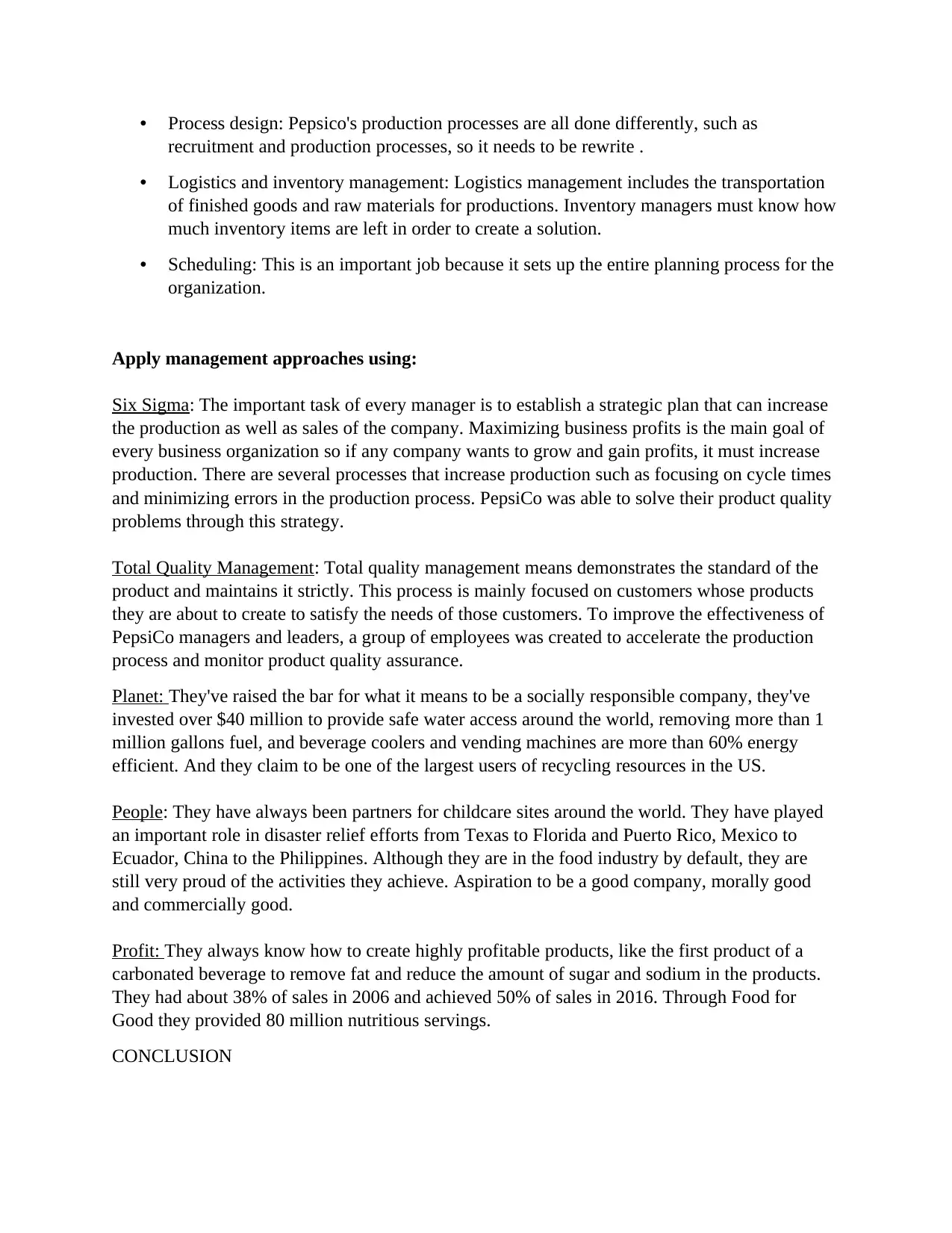
• Process design: Pepsico's production processes are all done differently, such as
recruitment and production processes, so it needs to be rewrite .
• Logistics and inventory management: Logistics management includes the transportation
of finished goods and raw materials for productions. Inventory managers must know how
much inventory items are left in order to create a solution.
• Scheduling: This is an important job because it sets up the entire planning process for the
organization.
Apply management approaches using:
Six Sigma: The important task of every manager is to establish a strategic plan that can increase
the production as well as sales of the company. Maximizing business profits is the main goal of
every business organization so if any company wants to grow and gain profits, it must increase
production. There are several processes that increase production such as focusing on cycle times
and minimizing errors in the production process. PepsiCo was able to solve their product quality
problems through this strategy.
Total Quality Management: Total quality management means demonstrates the standard of the
product and maintains it strictly. This process is mainly focused on customers whose products
they are about to create to satisfy the needs of those customers. To improve the effectiveness of
PepsiCo managers and leaders, a group of employees was created to accelerate the production
process and monitor product quality assurance.
Planet: They've raised the bar for what it means to be a socially responsible company, they've
invested over $40 million to provide safe water access around the world, removing more than 1
million gallons fuel, and beverage coolers and vending machines are more than 60% energy
efficient. And they claim to be one of the largest users of recycling resources in the US.
People: They have always been partners for childcare sites around the world. They have played
an important role in disaster relief efforts from Texas to Florida and Puerto Rico, Mexico to
Ecuador, China to the Philippines. Although they are in the food industry by default, they are
still very proud of the activities they achieve. Aspiration to be a good company, morally good
and commercially good.
Profit: They always know how to create highly profitable products, like the first product of a
carbonated beverage to remove fat and reduce the amount of sugar and sodium in the products.
They had about 38% of sales in 2006 and achieved 50% of sales in 2016. Through Food for
Good they provided 80 million nutritious servings.
CONCLUSION
recruitment and production processes, so it needs to be rewrite .
• Logistics and inventory management: Logistics management includes the transportation
of finished goods and raw materials for productions. Inventory managers must know how
much inventory items are left in order to create a solution.
• Scheduling: This is an important job because it sets up the entire planning process for the
organization.
Apply management approaches using:
Six Sigma: The important task of every manager is to establish a strategic plan that can increase
the production as well as sales of the company. Maximizing business profits is the main goal of
every business organization so if any company wants to grow and gain profits, it must increase
production. There are several processes that increase production such as focusing on cycle times
and minimizing errors in the production process. PepsiCo was able to solve their product quality
problems through this strategy.
Total Quality Management: Total quality management means demonstrates the standard of the
product and maintains it strictly. This process is mainly focused on customers whose products
they are about to create to satisfy the needs of those customers. To improve the effectiveness of
PepsiCo managers and leaders, a group of employees was created to accelerate the production
process and monitor product quality assurance.
Planet: They've raised the bar for what it means to be a socially responsible company, they've
invested over $40 million to provide safe water access around the world, removing more than 1
million gallons fuel, and beverage coolers and vending machines are more than 60% energy
efficient. And they claim to be one of the largest users of recycling resources in the US.
People: They have always been partners for childcare sites around the world. They have played
an important role in disaster relief efforts from Texas to Florida and Puerto Rico, Mexico to
Ecuador, China to the Philippines. Although they are in the food industry by default, they are
still very proud of the activities they achieve. Aspiration to be a good company, morally good
and commercially good.
Profit: They always know how to create highly profitable products, like the first product of a
carbonated beverage to remove fat and reduce the amount of sugar and sodium in the products.
They had about 38% of sales in 2006 and achieved 50% of sales in 2016. Through Food for
Good they provided 80 million nutritious servings.
CONCLUSION
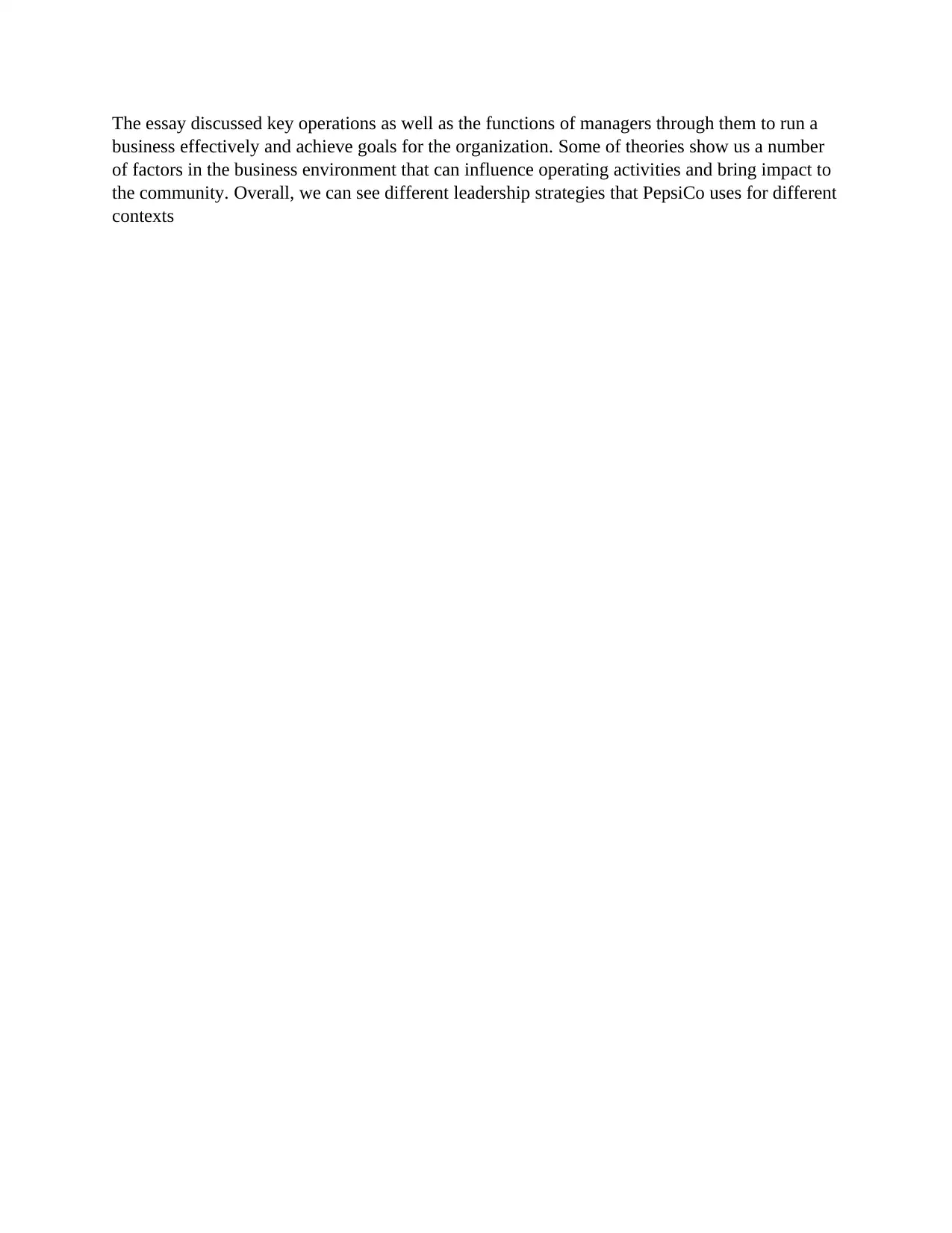
The essay discussed key operations as well as the functions of managers through them to run a
business effectively and achieve goals for the organization. Some of theories show us a number
of factors in the business environment that can influence operating activities and bring impact to
the community. Overall, we can see different leadership strategies that PepsiCo uses for different
contexts
business effectively and achieve goals for the organization. Some of theories show us a number
of factors in the business environment that can influence operating activities and bring impact to
the community. Overall, we can see different leadership strategies that PepsiCo uses for different
contexts
⊘ This is a preview!⊘
Do you want full access?
Subscribe today to unlock all pages.

Trusted by 1+ million students worldwide
1 out of 6
Related Documents
Your All-in-One AI-Powered Toolkit for Academic Success.
+13062052269
info@desklib.com
Available 24*7 on WhatsApp / Email
![[object Object]](/_next/static/media/star-bottom.7253800d.svg)
Unlock your academic potential
Copyright © 2020–2025 A2Z Services. All Rights Reserved. Developed and managed by ZUCOL.




